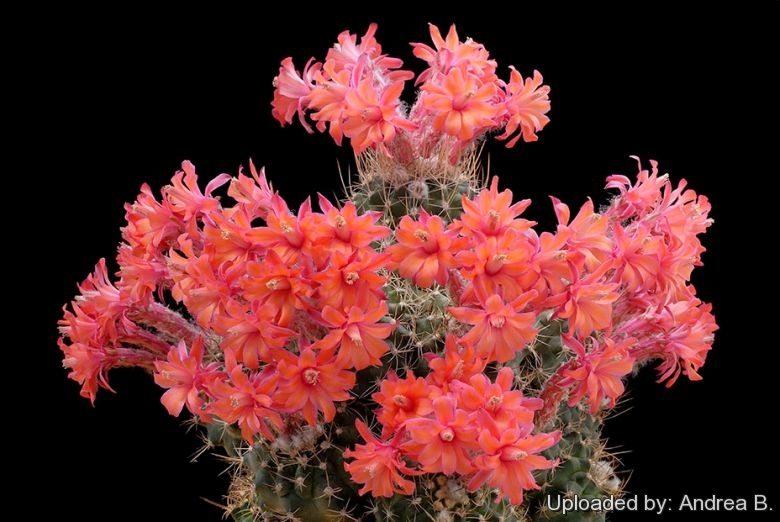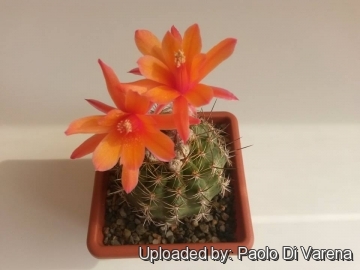Accepted Scientific Name: Matucana krahnii (Donald) Bregman
Kakteen Sukk. 37: 253. 1986

Borzicactus krahnii (Matucana krahnii) Photo by: Andrea B.
Origin and Habitat: Matucana krahniiSN|6031]]SN|6031]] has a relatively restricted range and is found only in Chachapoyas, North of Balsas, San Vicente Peru (Extent of Occurrence is 1,500 km2). There are more than five known locations (all in the Amazonas region).
Altitude range. This species grows at elevations of 800-1750 metres.
Habitat and Ecology: M. krahnii is usually solitary, but relatively common where it occurs. It grows in dry forest. In spite of its use as an ornamental plant, the population seems to be stable.
Synonyms:
See all synonyms of Matucana krahnii
back
Accepted name in llifle Database:Matucana krahnii (Donald) BregmanKakteen Sukk. 37: 253. 1986Synonymy: 4
back
Description: Matucana krahniiSN|6059]]SN|6031]] is a nice little clustering cactus that has a large wonderful bright red flower. This plant was described by John Donald in 1979. It is also known by its synonym Matucana callianthaSN|6059]]SN|6033]], a name given to it initially by Ritter.
Derivation of specific name: The epithet 'krahnii' has been bestowed in honour of Wolfgang Krahn, German cactus collector, travelled in Peru in the 1960s together with Paul C. Hutchison.
Stem: Flattened globular to globular up to 6(-8) cm in diameter and basally clumping, grey-green, with about 18 flattened ribs more or less resolved into conical to round tubercles.
Radial spines: 8 dark brown.
Central spines: 1-4 black, brown-tipped 0.5- 1 cm. long, later up to up to 6-8(-9)cm long and weakly twisted.
Flowers: Zygomorfic tending to lean on one side, diurnal, deep red and lilac coloured, about 7-8 cm long and 5.5-7 cm across.
Blooming season: Throughout late Spring or early Summer in several flushes over a long period.
Related species. Matucana krahnii is closely related to Matucana madisoniorum and Matucana paucicostataSN|6033]]SN|6059]], and some clones will make fairly large clumps relatively rapidly. It freely offsets like Matucana paucicostataSN|6031]]SN|6059]] but tends to have larger softer greener bodies, with long relatively weak twisted spines, but this species shows its superiority when flowering.
Subspecies, varieties, forms and cultivars of plants belonging to the Matucana krahnii group
 Matucana calliantha F.Ritter: Very similar (if not the same) to M. krahnii.
Matucana calliantha F.Ritter: Very similar (if not the same) to M. krahnii. Matucana krahnii (Donald) Bregman: It is a little clustering cactus that has a large deep red, exquisite zygomorfic flowers.
Matucana krahnii (Donald) Bregman: It is a little clustering cactus that has a large deep red, exquisite zygomorfic flowers.
Notes: Matucana krahniiSN|6031]]SN|6031]] is an example of hexagonal configurations of stem-segments surface, other plant that show hexagonal tubercles comprises Thelocactus hexaedrophorusSN|10830]]SN|10830]] and Tephrocactus geometricusSN|14349]]SN|14349]].
Bibliography: Major references and further lectures
1) James Cullen, Sabina G. Knees, H. Suzanne Cubey "The European Garden Flora Flowering Plants: A Manual for the Identification of Plants Cultivated in Europe, Both Out-of-Doors and Under Glass" Cambridge University Press, 11/Aug/2011
2) David R Hunt; Nigel P Taylor; Graham Charles; International Cactaceae Systematics Group. "The New Cactus Lexicon" dh books, 2006
3) Ostalaza, C. & Roque, J. 2013. Matucana krahnii. The IUCN Red List of Threatened Species 2013: e.T152597A655414. http://dx.doi.org/10.2305/IUCN.UK.2013-1.RLTS.T152597A655414.en. Downloaded on 22 January 2016.
4) Willy Cullmann, Erich Götz (Dozent Dr.), Gerhard Gröner “The encyclopedia of cacti” Timber Press, 1987
5) Edward Anderson “The Cactus family” Timber Press, Incorporated, 2001
6) “Matucana krahnii” in: British Cactus & Succulent Journal, Cactus & Succulent Society, 1993
7) Urs Eggli, Leonard E. Newton “Etymological Dictionary of Succulent Plant Names” Springer Science & Business Media, 29 June 2013
 Borzicactus krahnii (Matucana krahnii) Photo by: Paolo Di Varena
Borzicactus krahnii (Matucana krahnii) Photo by: Paolo Di VarenaSend a photo of this plant.The gallery now contains thousands of pictures, however it is possible to do even more. We are, of course, seeking photos of species not yet shown in the gallery but not only that, we are also looking for better pictures than those already present.
Read More... Cultivation and Propagation: It is not very hard to grow if protected from freezing temperature they needs care in cultivation to reach a good size without developing unsightly marks, need a minimum temperature of 10° C, but may survive a light frost. It benefits from a good light but not severe sunlight.
Grow in rich, porous cactus compost and let their soil dry out between waterings and water less in winter. Needs good drainage
Repot in the spring when their roots become cramped. Generally, they should be repotted every other year in order to provide fresh soil. However, this doesn't necessarily mean they'll need larger containers. After repotting, do not water for a week or more.
Propagation: Seeds or division, by detaching and rooting the little plants around the mother.











